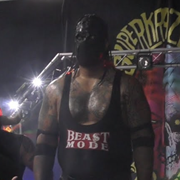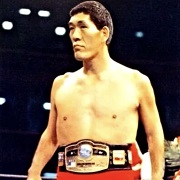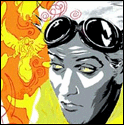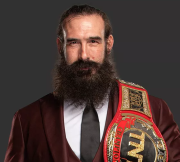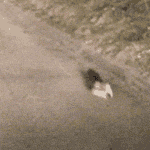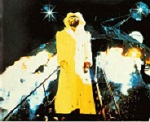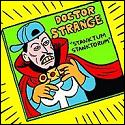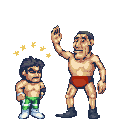|
There never seems to be the right place to post historical discussion, so here is a brief history of wrestling as it relates to the US and a place to discuss it! I'd like this thread to be the place to discuss classic wrestling, wrestling history or anything old that isn't WWE, WCW. Much of the early information comes from Karl Stern, so if you want more information his show on F4W and Stern Sticks are a great place to start. Much of the information about Montreal and Boston comes from Mad Dogs, Midgets and Screwjobs. This is not an exhaustive history, just an attempt to sum up a ton of history in one post. 1660 First known manual of wrestling published. 1730 Collar and Elbow wrestling becomes popular in American colonies. ~1800 Wrestling becomes a popular carnival attraction. Jean Exbrayat creates French Wrestling (Greco Roman) as a soldier in Napoleon's armies. 1830s Abraham Lincoln wrestles a series of matches against Jack Armstrong. A hybrid style of French and Freestyle begins to appear in the later half of the decade. Wrestling begins to see grandstand challenges in Paris with over the top nicknames and challenges. 1848 Exbrayat bans submission holds and grappling below the waist in French Wrestling. The style is later dubbed "Greco Roman" by Basilio Bartoli either to snub the French or to connect the sport to the ancient roots of wrestling. 1856 Wrestling is banned in Paris due to match fixing. 1860s Collar and Elbow becomes popular among Union soldiers. Col. James H. McLaughlin becomes first American champion in 67 but loses it in 68. McLaughlin is a Civil War veteran who won collar and elbow bouts in Union camp. He becomes a regional powerhouse in the Northeast, later wrestling nationwide. He was notorious for his strength, competing in both collar and elbow and catch matches. 1870 Introduction of padded mats. The same year Barney Smith died of injuries sustained in "Diamond Belt" championship match with McLaughlin. (I am not sure if there is a connection or which happened first.) 1871 Catch as Catch Can Wrestling is introduced, starting in England. 1873 "The Masked Wrestler" believed to be Thiebaud Bauer debuts in Paris, the first known masked wrestler. 1873 Again American Champion, McLaughlin loses the belt to John McMahon in a match where betting heavily favored McLaughlin. The result was not contested at the time. Early pro wrestling was worked for betting purposes, this may be an example. 1874 Viro Small becomes the earliest known African American wrestler. 1875 McLaughlin declares he will no longer wrestler catch as catch can style bouts after an opponent dies. 1880 William Muldoon an NY police officer wins American Greco Roman championship. Muldoon bcomes a rival of McLaughlin, engages in mixed matches and promoter of what might be called proto "sports entertainment." By 1880 wrestling is now believed to be largely worked. 1881 Muldoon quits the police force to concentrate on wrestling after his shift ends late and forced him to be hours late for a match. Later that year Muldoon wrestles a brutal 8 hour draw with Clarence Whistler in what is dubbed a "torture marathon." 1883 Sorakichi Matsuda, a sumo travels to the US and becomes first recorded Japanese professional wrestler. Whistler and Muldoon rematch which goes to a draw, Muldoon claims Whistler planned to throw him into the crowd to be beaten by thugs. Muldoon begins promoting matches with a time limit, the first promoter to do so. 1885 Whistler dies after a glass eating stunt. Evan "Strangler" Lewis wrestles a series of matches with Matsuda. In the rematch Matsuda threatened to shoot Lewis if he used his Strangle hold, so Lewis hospitalizes him with a leg lock. Lewis is the inspiration for Ed "Strangler" Lewis and famous for you guessed it, a rear naked choke. Later a rival of Farmer Burns. 1887 Strangler Lewis wins a Catch world title from Joe Acton after receiving a grandstand challenge. Muldoon retires after a boxer vs wrestler match which causes a riot and has widespread questions of legitimacy. Twenty pro wrestlers are brought to Japan for a sell out show, but the sport does not catch on. 1890 Muldoon returns to defeat Lewis in a Greco Roman bout. He retires as champion the next year. Martin "Farmer" Burns emerges as one of their premiere wrestlers, going undefeated for the next three years. Burns will win the American title, unify the Greco and Catch belts, and later on become an influential trainer to wrestlers such as Caddock and influenced the trainer of Ed Lewis. He is reported to weigh <160 lbs throughout his career. 1893 Lewis unifies American Greco and Catch titles to create the American Wrestling Championship. 1895 Lewis loses the title to Martin "Farmer" Burns with a finish that caused the crowd to chant "Fake." Newspapers also report the bout to be considered illegitimate. 1898 First Madison Square Garden sell out for wrestling. George Hackenschmidt debuts. Hackenschmidt will become the first consensus World Heavyweight Champion. 1899 Frank Gotch debuts. Gotch also wrestles under the name "Frank Kennedy" including obviously worked matches where both men tumbled onto the orchestra! Gotch also boxed.  Gotch would become the first American World Champion hold the Championship through multiple retirements. These retirements caused major problems with the idea of a "World Champion" and is one of the reasons anyone who says their belt dates back to 190X is making poo poo up. By this point wrestling is transitioning from a carnival and betting sport to a spectactor sport in stadiums and arena. 1901 Hackenschmidt wins European World Greco Roman championship. First tag team matches held in San Francisco. Strongman Louis Cyrl wrestles 8'2 "The Giant" Beaupre in Montreal. 1904 Gotch wins American title from Tom Jenkins bust loses it back the next year. 1905 Hackenschmidt defeats Jenkins to lay claim to a World Heavyweight Championship. Jenkins still defends the American title. Ed "Strangler" Lewis debuts.  1906 Stanislaus Zybyszko wins World Greco Roman championship in France. Gotch wins the American title a third time. 1908 Gotch defeats Hackenschmidt via forfeit to lay claim to the World championship. Fall Guys laid a number of claims about this match including a biased ref and questionable tactics by Gotch, Hackenschmidt claimed he greased later. 1910 Gotch defeats Zybyszko, handing him his first loss. George Kennedy a wrestler turned promoter purchases the Montreal Canadiens. Kennedy was a former Lightweight champion in Montreal, and upon losing his title to Eugene Tremblay he became his promoter. Kennedy learned the art of promotion from Farmer Burns, and acted as a modern day promotion, booking venues, scheduling matches and hyping them to the press. 1911 Gotch defeats Hackenschmidt in the two straight falls drawing 25,000 people in Chicago. The legend is that Gotch paid a training partner to injure Hackenschmidt prior to the match. It is more likely the match was worked and that was a face saving story. 1911-1920 Gotch retires multiple times, after different retirements he gives different wrestlers and matches his blessing for the title or a title fight. Charlie Cutler lays claim to the World title but is defeated by Joe Stetcher in 1915. Stetcher defends against Ed Lewis the same year but the gate money is confiscated due to the match not being on the level. Wladek Zybyszko, Lewis, Alexander Aberg, Earl Caddock and others emerge as stars. Mort Henderson becomes the first American masked wrestler, debuting in 1915 as the "Masked Marvel." In 1913, George Kennedy promotes a match between Stanislaus Zybyszko and Constant Le Marin in Montreal that draws 12,000 fans a record for the city that stands for 20 years. An International Tournament is held in New York from 1915-16. It becomes a huge fiasco at times, leading to a court fight involving a Stecher vs Masked Marvel title match. Alexander Aberg is awarded $5,000 for winning the tournament. George Bayley debuts a hypnosis gimmick. Stecher forfeits the world title to Caddock in 1917, but Caddock forfeits his title when he walks out of a tournament leading to Wladek being declared champion. Caddock then defeats Wladek the next year, but ends up serving in World War 1. Ed Lewis wins a disputed version of the World title in 1917, and goes back and forth with Wladek for that belt. Despite Caddock being the recognized champion, Lewis continues to promote himself as champion. Caddock retires, and Wladek is proclaimed champion by Jack Curley. Lewis then defeats Wladek to win the title, only to lose it to Stecher who is now the widely recognized champion. In 1918, Jack Curley, Billy Sandow and Tony Stecher began a talent trading agreement that encompassed the Northeast US as well as Montreal. 1920 Joe Stecher defeats Earl Caddock to become undisputed world champion in Madison Square Garden. The gate is 80K with Caddock being paid 15K and Stecher 25K. You can watch footage of the match here: https://www.youtube.com/watch?v=JQl6mmAtkbE It is hotly debated whether this match is a shoot or a work. Most title matches had been worked since the Gotch days, but I think the belief now is that this was a shoot. Don't quote me on this though! Wrestling will change greatly in coming years. Ed Lewis then wins the belt from Stecher in what Lou Thesz claimed was a shoot, but most now claim to be worked. If it was a shoot it was the last shoot World Championship match. 1920s Wrestling changes greatly from worked matches where it greatly resembles shoot matches to a more audience friendly style that comes to resemble what we today know as wrestling. The Goldust Trio of Toots Mondt, Billy Sandow and Ed Lewis taking a large part of the responsibility of that as they maintained a grip on the world title. Mondt becomes the first modern booker, and even when the group dissolves ends up with control of New York (which is important later!) Mondt is credited with what he calls the Slam Bang Western Style of wrestling, the more theatrical wrestling that combines, Greco, catch and well, fighting inside a boxing ring. They leverage Lewis as champion to do this, with the belief that Lewis is such a strong shooter he won't be able to be double crossed anyway. However, this is not the only world title during this period. Caddock, Stanislaus Zybyszko, Stecher and Londos will make claims various titles during this period, with Jim Londos posting grandstand challenges to Lewis. The Gold Dust Trio dissolves in 1928 due to infighting. Mondt ends up at war with Sandow's brother while Sandow and Lewis grow apart. Paul Bowser, an ally of Sandow ends up at war with Jack Curley for control of New York and Montreal. which leads to Jack Curley losing control of Montreal in 1929. Curley had controlled Montreal since the death of Kennedy in 1921 and revived it from a dark period in 24-26 by promoting Henri Deglane as a Francophone star. Jim Londos emerges as a huge star in the 20s and especially the 30s, but is often frozen out by Lewis. Londos reportedly draw nearly 100,000 fans in Greece, though this is disputed. He is known as being more style than substance, being a poor wrestler, but it seems that people are coming around on Londos, thinking his reputation may have been created by Lewis and Thesz who didn't like him. Wrestling becomes increasingly regionalized with Lewis and then others becoming touring champions. Lewis lets his grip on the title slip in the later part of the 20s, and we see non shooters start getting runs with the belt, like Gus Sonnenberg a football player with a signature flying tackle finisher. Paul Bowser agreed to pay Lewis $50,000 dollars to lose to Sonnenberg with a promise of additional $70,000 guarantee that Lewis would win the title back when Sonnenberg no longer drew. This leads to further fracturing of the world title. Sonnenberg is heavily backed by Bowser who at this point has a growing grip over the Northeast. 1930s Paul Bowser forms the original AWA, based out of Boston with Ed Don George as his primary star. The original AWA World Championship (not to be confused with Gagne's!) comes into existence in Boston and the National Wrestling Association title as well, both coming out of the Sonnenberg reign. Despite the promise to Lewis, Bowser puts the title on George without paying Lewis the guarantee. Lewis then double crosses George in Chicago at Wrigley Field. Lewis basically told George to cooperate or he would shoot on him, and George agreed, knowing he could not take Lewis. This leads to Henri Deglane vs Ed Lewis and the first Montreal Screwjob. Henri Deglane had continued to grow into a major star in Boston, Montreal and later France. In Montreal he drew 6-10,000 fans on a nearly weekly basis and several crowds numbering 25,000 at Braves Field in Boston. This makes him the perfect person to challenge Lewis for the title in Montreal. Lewis requested an American referee, but the Montreal commission instead instated Eugene Tremblay as ref. After Deglane won the first fall from Lewis, bite marks were noticed on Deglane's arm and Lewis was DQed, losing the fall and the title. Lewis claims he was double crossed, some historians believe Lewis was in on it, wanting a claim to the title but not the belt. Others believe Lewis, which is backed up by Thesz in his book Hooker. Londos becomes the first National Wrestling Association champion and he AWA and NWA belts are unified in 1935, but then a disputed split happens when the champion at the time Steve Casey leaves the country. Lou Thesz and Bronko Nagurski will hold the NWA belt multiple times as the decade closes. This NWA (not to be confused by the later NWA) is sanctioned by the an off shoot of the National Boxing Association. Casey and The French Angel seem to be the major stars for the Boston based AWA title. 1940s Wrestling is weakened as the Depression takes hold, and even more so by World War 2. This isn't to say it is completely dead, with Nagurski, Thesz and Londos remaining stars, the emergence of Gorgeous George and many others. Wrestling continued to become more fractured in the US with more territories and with it, more world titles. This leads to the creation of the National Wrestling Alliance in 1948. The NWA is basically an attempt to create a wrestling monopoly, with one recognized World Champion. Promoters can have their own regional champion, but not a world champion, they instead request dates on the NWA champion. Promotions that don't join the NWA are considered outlaws and promoters and wrestlers become blackballed from the NWA. Orville Brown becomes the first NWA champion and a unification match is planned with Association champion Thesz. However, Brown's career is ended in a car wreck and Thesz is awarded the Alliance title to become "undisputed" champion.  In 1949 wrestling also debuts on the DuMont network, which will help lead wrestling into its first televised golden age. 1950s Wrestling starts dramatically expanding on TV, and possibly most importantly: In 1953 Jess McMahon and Toots Mondt formed the Capitol Wrestling Corporation in New York City. Jess dies a year later, and his son Vincent James McMahon joins the business. This is basically the beginning of the WWE's legacy. The DuMont Network is the major hotbed for pro wrestling. It's weekly show is centered in Chicago, and Verne Gagne becomes its biggest babyface. Gagne becomes the US Champion and enjoys a national spotlight until the DuMont network falls apart in the middle of the decade. He's still a major national star. Thesz is the NWA mainstay, although a double cross with Edouard Carpentier in 1957 fractures that belt. Thesz gives way to Pat O'Connor in 1959, which sets up the creation of the modern AWA. By the end of the decade wrestling is all over TV on a territorial basis. Portland TV, Wrestling at the Chase in St. Louis and Houston begin decades long TV traditions. Jim Crockett Sr. gets his product on TV in the Mid Atlantic region, Capitol Sports is on in the North East, and there's many more. The territorial system is pretty much in place. 1960s-the death of the territories The decade starts with Gagne taking control of the American Wrestling Association. This AWA dated back to the 40s, but it is under Gagne that it becomes a major force. He can't get the NWA title, or even matches with Pat O'Connor, so he issues a grandstand challenge to O'Connor the world champion. The challenge isn't accepted and Gagne declares himself AWA world champion. Gagne dominates the belt, but other stars emerge throughout the decade including the Crusher, The Destroyer, Mad Dog Vachon and Dick the Bruiser. These men become the main draws of the promotion as Gagne becomes increasingly busy in running the company, despite still being champion. Gagne slowly releases his grip on the belt in the 70s, giving way to Nick Bockwinkel as the major singles champion, although Gagne retires as champion. The AWA goes on a tremendous upswing in the early 80s as Hulkamania begins, but also drawing on nostalgia acts such as Gagne and Vachon. Their talent is subsequently raided by the WWWF, leaving Gagne with an outdated TV show and no remaining stars. Today Gagne is laughed at for not making Hogan is champion, but the reality is if he did, Vince would have still raided Hogan. On top of that AWA wrestlers typically toured All Japan Pro Wrestling while Hogan toured with New Japan Pro Wrestling. Giving Hogan the belt would create a political mess there. Roy Shire begins promoting San Francisco in 1960, and his promotion starts heating up as Ray Stevens comes to town and feuds with Pepper Gomez. Ray Stevens becomes a huge star as a heel in San Francisco and is known as one of, if not the best worker of the period. In surveys of the time Stevens is selected not only as the most hated wrestler, but the most popular wrestler in local polls. Stevens teams with Pat Patterson as the legendary Blonde Bombers, and even gets a count out win over Bruno Sammartino, which in SF is regarded as clean. Shire promotes an annual battle royal that featured intricately booked storylines and was part of the inspiration for the creation of the Royal Rumble. In 1963, the World Wide Wrestling Federation or WWWF is formed as McMahon Sr. and Mondt break away from the NWA over Rogers losing the NWA title. They book Rogers as the WWWF champion, losing the belt to Bruno Sammartino in May of that year. Sammartino, who had just been blackballed from the NWA a few years earlier holds the belt the rest of the decade becoming an incredible draw and mainstream star in the North east. Bruno holds the title until 1971, when he dropped the belt to Ivan Koloff due to his desire to get away from the exhausting touring schedule. Pedro Morales succeeds Bruno, but fails to draw well outside of NY, prompting Vince Sr. to ask Bruno to return as champion for another year. Bruno wins the belt back in 73, and holds it until 77. During this period Bruno would be a major part of salvaging the WWWF's investment in the Inoki/Ali fiasco. They held the North Eastern closed circuit rights and the show was promising to bomb. Bruno had his neck broken in a match with Stan Hansen, and was virtually begged by McMahon to do a match on the show or it would risk the WWF's solvency, which they did, saving the live gate and maybe the company. After Bruno ends his second title reign Bob Backlund is selected to be the next major star of the company, though Bruno remains as a draw for major shows, in semi retirement. He also has a legendary feud with Larry Zybyszko in the early 80s that sets the territory on fire. At the same time Vincent Kennedy McMahon purchases the company, and within a few years is making his national expansion. The World Wrestling Federation and Titan Sports are born. Details on Inoki vs Ali quote:Inoki's basic strategy to become a star was to promote himself as a legitimate shooter. So he would book "mixed martial arts" matches where he'd fight various martial artists in worked matches and people would go "woah, Inoki is so much badder of an rear end than that fake rear end Giant Baba." The biggest possible "MMA" match he could book would be against the greatest boxer, so he offered Ali six million dollar to do a worked match. The story of the match would be Ali beats Inoki half to death with his boxing, with Lebelle trying to stop the fight to check Inoki's cuts. Ali would even ask Lebelle to stop the match, at which point Inoki would fire up, make his big comeback and pin Ali. So it would look like Ali had won the match, and it should have been stopped to make him look good, but Inoki would win and would take a brutal beating while not giving up which Japanese fans would love. Jim Crockett Promotions promoted wrestling dating back to the 1930s, but in the 60s and 70s would become a major force in the small Charlotte and Greensboro markets, under Jim Crockett Senior. Jim Junior then took over Mid Atlantic Championship Wrestling which became the promotion that eventually became WCW. The territory started out as a tag team centric promotion, something that seems impossible today. It became the flagship of the NWA during the 80s, having a stranglehold on the title, mostly centered around Ric Flair. The company promoted the first Starrcade in 1983, building on the region's Thanksgiving Day wrestling tradition. With Flair as champion and Dusty Rhodes as booker (and sometimes champion) the promotion remained red hot until the mid 1980s. However, things started burning out. McMahon's national expansion meant Crockett needed to go national too. Crockett, Gagne, and others formed an unlikely partnership in this period, creating Pro Wrestling USA. Pro Wrestling USA would be aired on ESPN, taping shows in the Meadowlands as a major shot at McMahon. Their supercards would feature the NWA and AWA champion, and with their combined talent rosters maybe, just maybe they could mount a challenge. They drew 21,000 in Chicago for Superclash I, but within months the alliance fractured. Crockett split and Gagne was left with the ESPN timeslot. If you've ever wondered why there are horrible AWA reruns on ESPN Classics, that is why. The AWA would try other alliances. Superclash III, their first Pay Per View was co-promoted with Memphis and World Class Championship Wrestling. WCCW is now infamous. Run by Fritz Von Erich, the promotion reached a golden era in the early to mid 1980s with Fritz's sons. Based in the Dallas Sportatorium for TV and doing major Stadium shows for their biggest cards the Von Erichs were gigantic stars in the area and big ratings draws. Their feud with the Fabulous Freebirds would draw for years and Kerry Von Erich even got a short NWA title reign. However, as I am sure most know drug abuse led to the deaths of all of his sons but one. Memphis I cannot even do justice to. Memphis basically created "sports entertainment" as we now know it, a weekly wrestling soap opera. Today it is most associated with Jerry Lawler, however Lawler was preceded by the recently deceased Jackie Fargo, who was every bit as big as Lawler at his peak. Lawler took over as the major draw when Fargo passed him the torch in a blood feud, and in the late 70s Jerry Jarrett and Lawler broke away from Nick Gulas to form their own promotion. They quickly came to dominate the territory with Lawler remaining on top throughout the 80s. This included a world famous feud with Andy Kaufman, however this feud only drew for a short period of time, despite its fame. Kaufman would never cash Jarrett's checks, so they kept booking him, feeling obligated. As the 90s dawned Memphis was struggling. Jarrett bought out WCCW and the territory was renamed the USWA, but they couldn't compete in the modern market. Lawler began part timing in the WWF, attempting to work as a heel there but a face in Memphis. Crowds dwindled until 1996 when Jarrett was forced to close. The territory would be restarted at various times, but it was finally killed dead by the 2007 match between Hulk Hogan and Paul Wight (Big Show.) Mid South Wrestling existed in some form dating back to the 1950s when it was run by Leroy McGuirk. He promoted Oklahoma, Louisiana and Mississippi until 1979. At that point, Bill Watts who had been headlining the promotion bought McGuirk out and renamed it Mid South Wrestling. Best known for its giant Super Dome shows in the 1980s with the Junkyard Dog as its attraction, it was a logically booked promotion that typically booked around big men for Watts to feud with, but also saw smaller tag teams introduced like the Midnight and Rock and Roll Express. Watts saw the writing on the wall in the mid 80s and began his own national expansion with television on TBS that outrated the timeslot Vince McMahon bought from Georgia Championship Wrestling, and a huge national syndication network. However paying for syndication crippled Watts and he was forced to sell to Crockett. Crockett, who also bought the timeslot Vince owned, found himself crippled in 1988 when Pay Per View revenue failed to appear. The WWF runs the first Survivor Series against Starrcade on PPV, crippling Starrcade. Vince then runs the first Royal Rumble on USA against Bunkhouse Stampede, hurting that PPV. Crockett fires back with Clash of the Champions up against Wrestlemania IV, seeing the double VHS mega-spectacle disappoint on PPV. However, the company was now spending a tremendous amount of money and sinking fast. There was a private plane, new offices in Dallas and no PPV revenue. The core fans in the Carolinas felt slighted as major cards moved to Atlanta and Chicago and Dusty's booking was burning through ideas weekly. By the end of 1988 the company was in debt and it was sold to Ted Turner to become World Championship Wrestling. WCW is the continuation of JCP, but major parts of the equation came from other promotions. Georgia Championship Wrestling was the promotion that held the TBS timeslot that Vince McMahon bought out. GCW dated back to the 40s, but its hey day would be in the 70s under Jim Barnett once they aired on Superstation TBS. Barnett would be ousted in 83 and the Brisco Brothers lasted a year before they sold to Vince McMahon, giving the timeslot to the WWF during their national expansion. Georgia itself had dabbled in expansion, promoting shows as far away as in Michigan thanks to its national reach. This is barely a drop in the bucket of territorial promotions. Houston had a long wrestling tradition, LA was a hotbed, Florida had Florida Championship Wrestling, the Sheik owned Detroit and the Bruiser owned Indiana. While the WWE claims Raw is the longest running whatever, it still cannot compare to the runs that Houston and Portland wrestling had on TV. Continental Championship Wrestling promoted the Deep South, not to be confused with Jarrett's Memphis promotion which also used the name Continental. Randy Savage's father than an outlaw promotion in Memphis which famously feuded with Jarrett's promotion both inside and outside of kayfabe. Montreal and Toronto have long wrestling traditions, as did Calgary with Stampede. I barely touched upon Wrestling at the Chase in St. Louis which not only has a longer history than Raw, but was attended by a high class audience. I haven't even mentioned Danny Hodge, or Mildred Burke who competed in what became a shoot fight for the women's title in 1954. There's a million things to talk about. I can't possibly do justice to the entire history of wrestling in the US, so I'll stop there. I'll try to update this OP as time goes on too, so if there is something wrong or a glaring omission, add it! Edit: Added some more details for the major pre 1910 stars. Edit 2: Added more information about early Greco Roman, and added debut of wrestling in Japan in 1877 and tag team matches in 1901. Edit 3: Added more regarding Montreal and the first screwjob up until the 1930s, so look through the early history for mentions of Montreal if you want to read the new additions. MassRafTer fucked around with this message at 22:10 on Dec 13, 2013 |
|
|
|

|
| # ? Apr 19, 2024 22:44 |
|
Good Resources: https://www.f4wonline.com for the Wrestling Observer and Karl Stern shows. http://www.prowrestlinghistory.com/ for tons of match listings and more. Memphis Heat, a great documentary on Memphis. Mad Dogs, Midgets and Screwjobs, a history of Montreal wrestling. Heroes of World Class, a documentary on the downfall of WCCW. Jim Crockett Promotions: The Good Old Days, a documentary on JCP. Flawed but interesting: Hooker by Lou Thesz, which isn't perfect but has a lot of good information about the first half of the 20th century. However it is biased towards Lewis and that camp's version of history. Fall Guys, a book from 1937 that exposes pro wrestling. It's hit or miss, but an interesting read. National Wrestling Alliance: The Untold Story of the Monopoly that Strangled Pro Wrestling is mostly very good, but has a few issues with how it is written. Bad Resources: Most WWE documentaries. Their company retrospectives are either biased or just lazy. The Unreal History of Professional Wrestling, a documentary that aired on A&E that is garbage. Anything by Scott Keith. MassRafTer fucked around with this message at 10:49 on Dec 13, 2013 |
|
|
|
I really enjoyed reading this post, it's hard to follow some of the earlier names with my lack of context. Would you have any speculation on the end of legitimate (meaning likely could win a shoot fight with anyone they were in the rig with) champions and start/cementing of "entertainer" champions?
|
|
|
|
FortifiedTumor posted:I really enjoyed reading this post, it's hard to follow some of the earlier names with my lack of context. I'll try to go in and add more context to the early figures, my original intention was "I can bang this out in 20 minutes!" Nope. The complete and total end of shooter champions would be in the 70s with the end of Jack Brisco's run. After that there wasn't really a concern from a national promotion with having a legitimate shooter on top, not that the WWWF ever cared or the NWA really cared that much in the late 60s and early 70s. There's traces of it in the 20s and 30s when wrestlers like Londos and football players like Nagurski start getting world titles. However at that time you still have certain strains of the world title trying to promote people with legitimate ability like Deglane, Lewis, Ed Don George and others. When they would stray they risked a double cross, not that the legitimate wrestlers didn't get double crossed too. By the time the 60s roll around it seems like only Gagne, Thesz and a shrinking minority of NWA promoters care about legitimate shooters.
|
|
|
|
That was an amazing read. I just wish I had something to realty contribute - a lot of the stuff in that OP I had never really known about before. Hoping this thread will continue to grow. Great job.
|
|
|
|
How did the Inoki/Ali fight get off the ground? It sounds like a crazy thing to me. I want to know more about Judo Gene's NWA promotion too and how that tied in with Lebell reffing the Inoki/Ali fight. Also, and this might fall a bit too far outside the purview of this thread, but who promoted Lebell's MMA fight with Milo Savage? What were the rules to that, was that promoted as a wrestling bout, etc? Great thread so far.
|
|
|
|
I could treat this thread like a "explain everything to me please" thread. http://www.grantland.com/blog/the-triangle/post/_/id/69760/wrestlings-greatest-shoots-wendy-richter-vs-the-spider-a-k-a-the-fabulous-moolah I read this and was somewhat amazed. "What I didn’t count on was the referee getting paid off." Was this statement kayfabe? Or were referees still somewhat legitimate into the mid 80's?
|
|
|
|
1st AD posted:How did the Inoki/Ali fight get off the ground? It sounds like a crazy thing to me. Inoki's basic strategy to become a star was to promote himself as a legitimate shooter. So he would book "mixed martial arts" matches where he'd fight various martial artists in worked matches and people would go "woah, Inoki is so much badder of an rear end than that fake rear end Giant Baba." The biggest possible "MMA" match he could book would be against the greatest boxer, so he offered Ali six million dollar to do a worked match. The story of the match would be Ali beats Inoki half to death with his boxing, with Lebelle trying to stop the fight to check Inoki's cuts. Ali would even ask Lebelle to stop the match, at which point Inoki would fire up, make his big comeback and pin Ali. So it would look like Ali had won the match, and it should have been stopped to make him look good, but Inoki would win and would take a brutal beating while not giving up which Japanese fans would love. It was win win, and Inoki partnered up with several US promoters to do closed circuit, including the WWWF in Shea Stadium. However, the press started asking Ali why he was doing pro wrestling which started giving him second thoughts. The boxing community didn't like that wrestling was controlling the promotion of this and making boxing out to be the heel in their hype got into Ali's head too. Ali did a few worked matches on US TV to hype it up, and flew to Japan where he told Inoki he didn't want to do this worked loss, which led to the whole show almost falling apart until Inoki agreed to make it a shoot since he wasn't going to pay $6,000,000 to do a worked loss. To make the fight happen Inoki agreed he wouldn't be able to kick to the head, suplex, punch or choke. That led to him laying on his back and kicking at Ali's legs, occasionally trying for a takedown. This did a ton of damage to Ali's legs, landing him in the hospital. As for why Gene was involved, he was a business manager for Inoki. On top of his legitimate background that connection made him kind of perfect to be the ref here. I'll try to do a write up on the Lebelle LA promotion next. I wanted to include it originally but blanked on everything but the famous Tolos feud with Blassie.
|
|
|
|
Thank you for this. Now I have something to point to when some of my idiot friends refuse to believe that pro wrestling has a history that goes back before 1980.
|
|
|
|
Thanks for the thread! I've become much more interested in wrestling's history over the past couple years thanks to Dave Meltzer and it's nice to have a place to discuss it. I'll have to check out that Memphis Heat doc.MassRafTer posted:Ali did a few worked matches on US TV to hype it up The rest of the Ali vs. Inoki stuff I basically knew, but I never heard about Ali's worked matches before. Who were they against and is any footage available online? quote:Sammartino, who had just been blackballed from the NWA a few years earlier.... Thauros fucked around with this message at 13:35 on Dec 8, 2013 |
|
|
|
This is a great thread, so I went hog wild and voted 5! My question is why did Pro Wrestling USA fall apart so quickly? Since it's pro wrestling, I feel pretty safe to assume "egos," but knowing what in particular happened would be interesting.
|
|
|
|
Thauros posted:Thanks for the thread! I've become much more interested in wrestling's history over the past couple years thanks to Dave Meltzer and it's nice to have a place to discuss it. I'll have to check out that Memphis Heat doc. Bruno had a falling out with Vince Sr, over what I forget and Vince pulled a trick where Bruno was booked for two dates on the same day, one of which he didn't know about. This led to Bruno being suspended by athletic commissions throughout the country for no showing the date and left him out of wrestling for a short time. Frank Tunney then hired him to work Toronto, he was a huge success and Vince Sr. came crawling back. As for the Ali footage, he did three squashes that aired on ABC's Wide World of Sports. I don't know who the opponents were, probably AWA jobbers.
|
|
|
|
MassRafTer posted:Bruno had a falling out with Vince Sr, over what I forget and Vince pulled a trick where Bruno was booked for two dates on the same day, one of which he didn't know about. This led to Bruno being suspended by athletic commissions throughout the country for no showing the date and left him out of wrestling for a short time. Frank Tunney then hired him to work Toronto, he was a huge success and Vince Sr. came crawling back. So basically, Vince Sr. was just as scummy as Junior, just in his own way.
|
|
|
|
John Cena
|
|
|
|
Thank God for Toots Mondt.
|
|
|
|
Really fantastic OP. I didn't know a lot of the really early stuff, and would love if you could expand on "catch" as a style, it's development, deaths, etc.MassRafTer posted:Bruno had a falling out with Vince Sr, over what I forget I may be mistaken, but I think Vince wanted Bruno to go full time with the WWWF and he declined. I know Bruno talked about it on a couple Observer podcasts.
|
|
|
|
As others have said, awesome thread. I've always been interested the early history but never found a good resource, this is great. I've always wanted to have a better grasp on the territory system in terms of who had claim to what areas exactly and when, at least for the 60's through the 80's. Is this possible? Hell, if anyone was really bored a map would be astounding.
|
|
|
|
Onmi posted:So basically, Vince Sr. was just as scummy as Junior, just in his own way. Oh yeah absolutely, Vincent J. was well known for screwing dudes on money and blackballs and all those wonderful promoter tactics. He was what he needed to be in that time.
|
|
|
|
AlLamonaca posted:As others have said, awesome thread. I've always been interested the early history but never found a good resource, this is great. I've always wanted to have a better grasp on the territory system in terms of who had claim to what areas exactly and when, at least for the 60's through the 80's. Is this possible? Hell, if anyone was really bored a map would be astounding. I can't tell you who ran each territory, but here's an incomplete list: Canada: Maritimes: a summer only territory run out of the maritime provinces, I think these shows stopped in the 90s. Quebec: All Star Wrestling associated with the Rougeaus, and the shorter lived Grand Prix wrestling with Carpentier and the Vachons. Both were gone by the mid 70s. Toronto: Run by the Tunneys, Jack Tunney got his WWE gig when the territory was sold to Vince during the expansion. Calgary: Stampede run by Stu Hart United States: Northeast: WWWF run by the Vinces Mid Atlantic: Run by the Crocketts Georgia Championship Wrestling: Run by Barnett with Ole booking for at least part of that run, then the Briscos before selling to Vince. Championship Wrestling from Florida: Run in the later years by Eddie Graham until his suicide when Matsuda took over and sold to Crockett in 87. Continental: Run out of Alabama, the panhandle and parts of Kentucky, died off in 1990, run by Roy Welch and the Fullers until near the end. Memphis (really TN and some surrounding cities, not just Memphis) was Nick Gulas' territory until Jarrett and Lawler took it over in 77 forming their version of Continental/USWA which ran until 96. Various revivals afterwards. Savage's father ran IWA In the same region. WWA: Ran in Indiana and Illinois, Dick the Bruiser's fed which he ran until his death in 1991. Now his son runs the incredible Bruiser Championship Wrestling. Big Time Wrestling: The Sheik's promotion, ran in Michigan and Ohio, The Sheik was a huge success until he burned the territory out in 1980. St. Louis: Famous for Wrestling at the Chase, Sam Muchnick's group until 82, I think he sold to Larry Matysik who sold to Vince in 84. Central States/Heart of America: Iowa, Kansas and part of Missouri. Run by Geigel during this period until he sold to Crockett, then bought it back and went out of business a year later in 88. Before going out of business he tried to create a new sanctioning body, the WWA. No relation to Bruiser's, I believe. Mid South: Run by McGuirk and then Watts, Oklahoma, Arkansas, Louisiana, sold to Crockett during his expansion. WCCW: Based in Dallas, ran North Texas until 1990. Houston: Run by Morris Sigel, then Paul Boesch until 87 when he sold to Vince. Boesch was in many way's Meltzer's mentor. Amarillo: run by the Funks (I think) until 1981. There were was a sub territory in Abilene run by the Lawman. Southwest Championship Wrestling: Owned by Joe Blanchard in San Antonio NWA Hollywood/World Wrestling Association: The Lebell promotion, the Carpentier double cross of Thesz led to the creation of the WWA title from that lineage, but they eventually rejoined the NWA and closed in 82. By 82 the promotion was apparently completely horrible, if you've seen the footage of THE MONSTER that won the Observer Award for Most Disgusting Promotional tactic you can see why. (It wasn't disgusting, just insanely low rent.) San Francisco: Run by Roy Shire until 1981. Oregon: Portland was the center, they also ran in parts of Washington. Owned by the Owen Family until 92, Sandy Barr then started promoting the territory until 2001. Hawaii: I know the Maivia's ran a group here, but I'm not sure of many details. AWA: Sort of half territory half national group. The AWA was centered in Minnesota, Wisconsin and Chicago with a sub territory in Nebraska. As time went on it expanded to Winnipeg, Colorado, San Francisco and Vegas. There are more, I'm pretty sure Pittsburgh was its own sub group at points and I know there's more out west and possibly in the South. This is mostly the groups that died in the 80s, but more existed in the 60s, that's just past the scope of my knowledge. Strenuous Manflurry posted:Really fantastic OP. I didn't know a lot of the really early stuff, and would love if you could expand on "catch" as a style, it's development, deaths, etc. That sounds right. I don't know too much about the deaths in catch wrestling, I imagine it comes from the style opening up new ways for slams and holds that would be outlawed in Greco Roman which was the more popular style of professional wrestling at the time. Basically Catch means "catch a hold wherever you can" so you can grab holds or throws anywhere on the body, except the rear naked choke, which is why some wrestlers objected to Evan Lewis. The idea as I understand it is submissions were supposed to be tricky and applied quickly, rather than something you would slowly work for. I guess this is where the term "hooking" comes from. As a style it works a bit like MMA without striking, but with pinfalls. I'd say better than describing it, checking the Stecher/Caddock footage would give a good idea of what the style was like. The existence of pinfalls makes it different from jiu jitsu since working from the guard is a big risk, so it was heavier on the top game in terms of being a "shoot." Unfortunately I don't know a ton about it beyond those basics I've picked up from various reading I've done, some interviews with fighters who do catch and watching old footage to try and put it together. I don't know anything about the deaths other than they happened. Rodney the Piper posted:This is a great thread, so I went hog wild and voted 5! Promoters were trying to make their own guys look good while Crockett was doing things like trying to sign other's talents. Because of politics they did few interpromotional matches and people just weren't over in certain markets which made TV a huge problem. On top of Gagne and Crockett you had Jerry Jarrett and other small promoters involved so it was really a mess of too many people involved in something that probably didn't have a viable business plan anyway.
|
|
|
|
MassRafTer posted:
The local Pittsburgh org was simply called Studio Wrestling and ran on Channel 11 from '59 to '72. That's the main wrestling my dad grew up watching, and you'll still occasionally hear local baby boomers using it as an analogy when comparing something to the worked theatricality of pro wrestling. Like a lot of other promotions of the time and pre cable local tv in general, virtually all the footage is lost  As I brought up in the Q&A thread at one point, they apparently had an interesting relationship with the WWWF that I'd like to know more about. Toots Mondt was apparently the main guy behind it in addition to his partnership with Vince Sr. They promoted Bruno as champ with his WWWF belt, but simply as the "World Champ" with no mention of the company. The WWWF themselves also ran shows in Pittsburgh for at least most of that period as well. Thauros fucked around with this message at 15:17 on Dec 10, 2013 |
|
|
|
Pro Wrestling This Week was one of my favorite shows. It was really cool to see the stuff going on in the other territories. https://www.youtube.com/watch?v=vQNcwxV8ywQ
|
|
|
|
This is all just US right because I came across (on another forum) a write-up from 2009 (around when Takeshi Matsunaga passed away) on the history of All Japan Women's Pro-Wrestling. If nothing else it's an excuse to post a long Meltzer history piece.  It'd be cool if anyone who knows about Japan, Mexico, Britain, etc. could go into the history of those places too.
|
|
|
|
What's the oldest filmed match that's actually worth watching?
|
|
|
|
There was a Vancouver promotion that was pretty hot, Piper, Rick Martel, Raven (as Scotty Flamingo), and the Moondogs all did shots there. Here's more info http://en.wikipedia.org/wiki/NWA:_All-Star_Wrestling El Gallinero Gros fucked around with this message at 21:17 on Dec 10, 2013 |
|
|
|
Suben posted:This is all just US right because I came across (on another forum) a write-up from 2009 (around when Takeshi Matsunaga passed away) on the history of All Japan Women's Pro-Wrestling. If nothing else it's an excuse to post a long Meltzer history piece. If people want to post histories of other countries they are more than welcome. I only limited it to the US because trying to do every country would be absolutely maddening. EugeneJ posted:What's the oldest filmed match that's actually worth watching? Probably this from 1913: https://www.youtube.com/watch?v=CLNfu5GXuhQ I believe that quick clip you see in the WWE intro is from even earlier, and then there is this from 1895: https://www.youtube.com/watch?v=ehdxytFM2I0 There was something floating around from 1901 but I can't locate it.
|
|
|
|
EugeneJ posted:What's the oldest filmed match that's actually worth watching? The best I've seen is Giant Baba vs. The Destroyer in 1969. https://www.youtube.com/watch?v=Kux2oSH7Cz0 There may be some pretty cool matches before this, but IMO this is the best matched I've ever seen that took place before 1980.
|
|
|
|
Price Check posted:The best I've seen is Giant Baba vs. The Destroyer in 1969. I think Baba's muffler's falling out.
|
|
|
|
Pneub posted:I think Baba's muffler's falling out. I watched and thoroughly enjoyed that match a while back and yeah that exact thing kept me from really getting into it.
|
|
|
|
This is pretty long and maybe kind of wall of textish but it's a good read imo on the history of AJW.quote:
Suben fucked around with this message at 22:18 on Dec 11, 2013 |
|
|
|
Double posting but that's because the other one was getting too long. Anyway it was glossed over there but here's a bit on Jackie Sato's retirement and the history of JWP. She, Nancy Kumi, and kickboxer Rumi Kazama started JWP in 1986 and recruited a lot of AJW castoffs either those who couldn't pass the auditions or who washed out of training. They also recruited Shinobu Kandori who had recently (in 1984) won a bronze medal at the judo world championships. From the outset there was a lot of tension between the "entertainers" (Sato, Kumi, the pro wrestler types) and the "shooters" (Kazama, Kandori, etc.). It exploded during a match in 1987 between Sato and Kandori. No clue if footage exists of it but at some point early in the match it turned into a shoot (no clue which of the two started it) with Kandori locking a hold on Sato and having to be pulled off. AFAIK that was Sato's last match and she retired not long after. The two sides still hated each other though and in the early '90s Kazama got fired which caused a bunch of her supporters (Kandori, Harley Saito, Eagle Sawai, etc.) to leave with her and form Ladies Legend Pro Wrestling (LLPW) while the ones who stayed (Mayumi Ozaki, Dynamite Kansai, Plum Mariko, Devil Masami, etc.) reorganized as JWP Project. From reading around JWP and LLPW legit hated each other and refused to work together after the split never even interacting/feuding with each other during the interpromotional era that started in '93. The one exception to this was Plum Mariko who had friends on both sides and was the only person against the split so much so that she was the only JWP wrestler who worked LLPW's first show. Plum's definitely one of the saddest cases in wrestling because her career kept getting derailed by injuries and eventually her head was so screwed up by concussions that she was regularly forgetting finishes, sequences, etc. Then on August 15, 1997 she took a ligerbomb from Mayumi Ozaki which triggered a brain abscess (due to the repeated head trauma throughout her career), put her into a coma, and she died a few hours later becoming the first Japanese wrestler to die due to injuries in a match. Around the same time Candy Okutsu and Hiromi Yagi (two of their top young stars) retired and within a year or two Kansai, Ozaki and a bunch of others left for Chigusa Nagayo's GAEA promotion, and the promotion closed in 2000 before coming back a few months later with Command Bolshoi as head booker (and she's probably one of the most unselfish examples of a booker/wrestler in history) and has been running since. LLPW ran shows inconsistently during the 2000s, relaunched as LLPW-X but hasn't run a show in years. Edit: And on another non-JWP note but related to Jaguar Yokota and making her the new star, she wasn't the original choice. Originally it was supposed to be Tomi Aoyama. I'm not sure when exactly/how long the Sato/Nancy Kumi version of the Beauty Pair lasted but the New Beauty Pair incarnation I've heard of more was Sato/Aoyama. Aoyama is one of the biggest missed opportunities/what ifs I can think of for AJW. She kind of moved in and out of being part of the New Beauty Pair with Sato and the Queen Angels with Lucy Kayama (Kumi, I think, is more well known for being part of the Golden Pair with Victoria Fujimi) and was more the tomboyish type than the pretty type (like Ueda, Kumi, or Kayama). She was also insanely athletic. There's not a lot of her stuff, at least on youtube, but what's there you can really show that athletically she was just on a completely different level than anyone AJW had until maybe a decade later sans Jaguar. Great dropkicks, busting out planchas and no-handed springboards in the late '70s, etc. But she wound up injuring her knee which took away her high flying style and forced her to retire in 1979 which left AJW without their planned post-Jackie ace before settling on Jaguar. Edit 2: The big AJW write up in the previous post was, I believe, from Meltzer in a July 2009 (not sure of the exact date) Observer issue and was reproduced by a user over at joshifans called Hooligan69. A lot of the Plum Mariko information comes from Mike Lorefice. Suben fucked around with this message at 09:13 on Dec 14, 2013 |
|
|
|
I'd love to write something up on the Stampede territory and Western Canada, but I'd have to reread a couple of books to do it. I'll follow the thread and contribute where I can.
|
|
|
|
Psychlone posted:I'd love to write something up on the Stampede territory and Western Canada, but I'd have to reread a couple of books to do it. I'll follow the thread and contribute where I can. Make sure you cite the Heath McCoy one, it owns. The Pain and the Passion. I'll be contributing as much as I can to this thread once I cop the Montreal territory book, Midgets, Mad Dogs, and Screwjobs.
|
|
|
|
El Gallinero Gros posted:Make sure you cite the Heath McCoy one, it owns. The Pain and the Passion. I'll be contributing as much as I can to this thread once I cop the Montreal territory book, Midgets, Mad Dogs, and Screwjobs. The writing is a little rough, but it's really good. Writing this thread actually re-enforced what the authors say about Montreal being really important throughout wrestling's history, so I went back and added some extra details from the book up through the 1930s. Control F for Montreal and it should all pop up! Also, Suben could you (and anyone else who posts other people's work) cite whoever it is even if it is a screen name? I'd really like to credit people who do good work, and it can be nice in other ways. For example, if someone finds a Scott Keith piece or something of that nature and posts it. Scott Keith's work is really really bad for anyone who doesn't know! MassRafTer fucked around with this message at 10:53 on Dec 13, 2013 |
|
|
|
Here's a guide to the history of FMW, which had a big influence on ECW and Japanese indy wrestling in general, by DVDVR poster BAHU. My apologies if it doesn't quite fit the theme of the thread, but it's a really good read http://www.puroresucentral.com/FMW.html
|
|
|
|
Great stuff. Where did Inoki get the 6 million for Ali? Yakuza backing?
|
|
|
|
sticklefifer posted:John Cena
|
|
|
|
El Gallinero Gros posted:Here's a guide to the history of FMW, which had a big influence on ECW and Japanese indy wrestling in general, by DVDVR poster BAHU. My apologies if it doesn't quite fit the theme of the thread, but it's a really good read Any sort of historical piece fits the theme of this thread. Bigass Moth posted:Great stuff. Where did Inoki get the 6 million for Ali? Yakuza backing? I have no idea. I should say I forgot that Ali ended up only getting $2 million to do the shoot fight version of the fight. He was supposed to be paid $6 million to do the job for Inoki, but when he refused his pay got dropped to $2 million. That ended up with some lawsuits and I have no idea how those worked out. MassRafTer fucked around with this message at 22:09 on Dec 13, 2013 |
|
|
|
I have a real hard time getting a grasp on how seriously people took pro wrestling in the past, but would jobbing in a fake fight really have hurt Ali at all?
|
|
|
|
1st AD posted:I have a real hard time getting a grasp on how seriously people took pro wrestling in the past, but would jobbing in a fake fight really have hurt Ali at all? Wrestling was taken pretty drat seriously in the past. This is the era where a fan fired a gun at Bobby Heenan and Nick Bockwinkel in Chicago, where heels got showered in piss, stabbed, threatened, where Mad Dog Vachon would start crowd riots due to his heeling and have to fight the crowds to get back to the locker room. The wrestlers took it very seriously too, when Jack Brisco was scheduled to win the NWA title from Dory Funk Jr. it never happened because Funk got into an accident and was too injured to do the match. Brisco swore until the day he died that Funk faked the accident and injuries to keep from having to job to Brisco. Kayfabe was strictly kept and wrestlers were seen as legit badasses even though people knew it was fake. Ali was offered more money than he got for any boxing match up to that point to do the job which gives you an idea of how seriously he took it before he got second thoughts. Now, beyond the general landscape of wrestling in that era, look at the specifics. -Inoki was booking himself in these matches against legitimate martial artists to build up his own credibility as a legitimate bad rear end. -The matches were called "mixed martial arts" to try and differentiate the matches from worked pro wrestling. They were still worked, but they were promoted a different way. -Inoki was selling himself in the build as a world's martial arts champion rather than a fake pro wrestler. -There was a major theme of wrestling vs boxing in the build and also with the promotion, with boxing feeling insulted and cut out of something involving their major star. -On top of that, the press found out Inoki wasn't a martial arts master and began making a mockery of the thing to Ali, including Cosell making light of the whole idea as he called the Ali squashes on Wide World of Sports. So you had this weird three fold pressure on Ali. He's being told that hundreds of thousands of fans will see this fight throughout the US at the closed circuit locations and they are being told this is martial arts master vs boxing champion in a mixed martial arts fight, so they might believe its real. The press thinks it is a joke and it is making him feel like a joke to be a part of it, and it is pissing off the people who he makes his regular money off of.
|
|
|
|

|
| # ? Apr 19, 2024 22:44 |
|
Since LA was asked about, here's the story of the Carpentier/Thesz title fiasco that led to LA breaking away from the NWA. In 1957 Thesz was due to make an international tour. The NWA affiliates didn't want to be without a champion during that period, and didn't want Thesz making unapproved title switches in Japan. They decided to switch the title before Thesz left. Edouard Carpentier was chosen to be the champion in Thesz's absence. The title change was done in Chicago with the referee declaring Thesz unfit to continue during the third fall and Carpentier being awarded the championship. The fall was called a DQ in the press and the NWA announced it would decide the matter of who the champion was. Carpentier then began defending the belt in promotions that recognized him, which started not sitting well with his promoter Eddie Quinn. Carpentier was doing huge business in Montreal and he was losing dates on him. A return match was announced for Montreal and Carpentier lost the third fall via DQ, which was announced by Quinn as resulting in a new champion. Sam Muchnick declared Carpentier was still the champion, and in turn Quinn withdrew from the NWA. This led to Carpentier's reign becoming unrecognized and Thesz then lost the belt to Dick Hutton. This didn't sit well with certain promoters who wanted Carpentier, not Hutton to be the champion. One of them was Mike Lebell's promotion in LA. They renamed themselves the North American Wrestling Alliance (Later World Wrestling Association) and made Carpentier the NAWA champion. This title lineage would continue until 1968 when they rejoined the NWA and recognized its champion.
|
|
|


